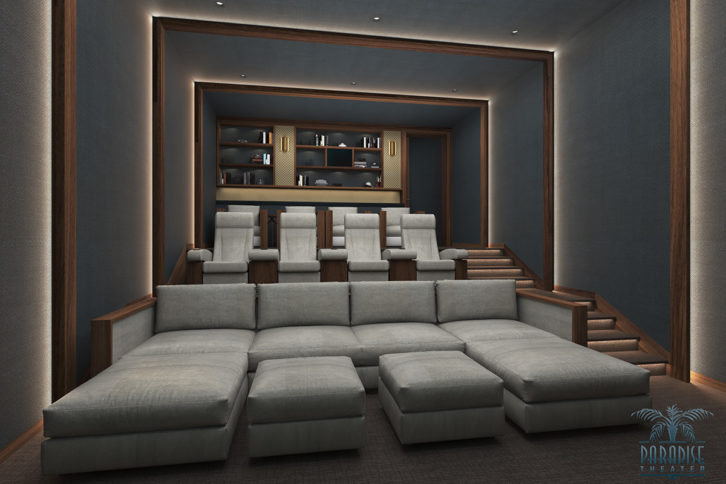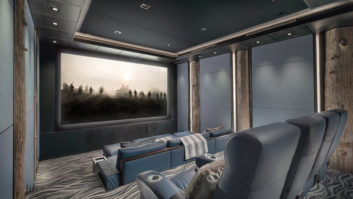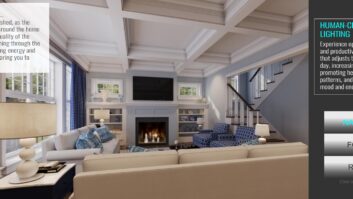
For all our differences, we are more alike than not. One trait we generally share is the ability to spot the flaw. To make matters worse, once detected, a single imperfection is difficult to overlook. Like the first scratch on a new car, our attention is drawn to the offending detail, obscuring the beauty that might surround it and stealing an unwarranted portion of the pleasure we seek.
For private cinemas, this tendency has much potential to occur. Private cinemas encompass many attributes and disciplines, each with its own set of considerations. From the many aesthetic elements that comprise the décor, to the performance of the system, to the performance of the room itself, there are innumerable details that must be executed properly and that must also integrate with other attributes and disciplines. In the words of Leonardo da Vinci, “Details make perfection, and perfection is not a detail.” While perfection, some may argue, is not expected, those observing a flaw in our work will not recall such a caveat!
Also by Sam Cavitt: The Who, What, When, Where, Why, and How of Private Theater
Imperfections can be hard to spot. Such inconspicuous defects however, can prove to be the most insidious. Certainly, a flawed fabric, finish, or fixture is easily spotted and reasonably simple to correct. An out-of-phase loudspeaker or imperfect video calibration, more subtle, but competent technicians should catch these. The kind of hidden flaw I am referring to are those that result from poor planning, collaboration, or oversight. These elusive miscues may avoid detection initially only to be discovered by the client at a later date. Such delayed discontent can leave a more bitter taste than the apparent and easily remedied sort and, once detected, be impossible to disregard. Examples of such subtle imperfections include mechanical systems that perform above the target noise floor when the room’s heat load increases; lighting design that fails to illuminate critical paths, casts unpleasant shadows, dims improperly, etc.; break-in noise that occurs intermittently due to the failure to investigate all potential noise sources in the home…the list goes on ad infinitum.
The alarming fact is, these types of miscues are difficult, if not impossible to correct after completion! Private cinema planning integrated with the architectural planning process can serve us well in our pursuit of perfection.
One of the challenges for private cinema planning is the fact that we are not always presented with an ideal scenario. A truly ideal scenario is when the cinema can be planned from the very earliest stages of the project. In the architectural practice there is a phase entitled “programming.” This “pre-design” phase is where the broad strokes of a project scope will be determined, objectives established, and rough budgets discussed. Generally, the description and use of every room to be included in the project will be determined. It is this last item that makes the programming phase the ideal time for a cinema designer to be involved. We have had the opportunity to be brought in on programming discussions where very rough floorplans had been sketched out and the cinema preliminarily placed. In these cases, we have been able to share concerns on poor entry locations, problematic adjacent spaces, inadequate access for mechanical systems, and more. The cost of correction was pencil lead and transparent drawing paper rather than demolition and reconstruction, or worse yet, an irreparable defect.
All is not lost when the project has progressed beyond programming into schematic design. In this phase the floor plans, site plans, and building elevations are developed, including planning for structural, mechanical, HVAC, plumbing, and electrical systems. Short of being involved in the programming stage, it is vital that the cinema designer have input at this juncture as early as possible. If schematic design has developed to a great degree, there will be resistance to recommended changes as an architect and their consultants (structural, mechanical, and electrical engineers) will have invested some effort into a solution. Nonetheless, if that solution is not supportive of an optimum cinema, it is imperative that these shortcomings be identified and addressed before even more work progresses. It would be better to absorb the cost of re-planning than the expense of rebuilding, or, again, an unaddressed flaw.
The design development phase brings about what is really our last chance to make significant changes without significant cost. In this phase, the general direction of the project has been determined. Those projects with a private cinema (and shouldn’t all homes include one!) would have a space designated, although without knowledgeable input it is likely to have some inherent concerns. Consideration of noise control, interior acoustics, audio-video system positioning, audience positioning and myriad other interdependencies that are the purview of the cinema designer are often overlooked. If the cinema designer is consulted at this point, it is likely that design work by others will need to be revised. While the design development phase is not the final design stage, it is likely getting close and changes will not only have a monetary impact, but also start to affect the schedule.
We have been put in the position where, due to such cost and scheduling issues, we were advised to remain quiet and “go along” with the program. This is a challenging position, but the client is owed an accurate assessment and the opportunity to decide for themselves the outcome of their cinema. Failure to do so does not mitigate a problem but only delays disappointment and, ultimately can cost dearly.
Also by Sam Cavitt: Immersive Sound – More Than a Numbers Game
In the CD phase (construction documentation) things are starting to get serious. At this point, permit sets have likely been submitted to building departments and bid sets have been submitted to contractors. The proverbial clock is ticking and, as the saying goes, time is money! Still, defects due to poor planning are better addressed than ignored, even in the face of strong resistance.
Truly, in the case of a private cinema, this may be the last chance to prevent a common and egregious error — that being the unsuitable overall room size and excavation plan. Many oversimplify what it takes to determine these specifications, however, to get it right, consideration of numerous interdependent factors have to be analyzed. Getting it wrong means the resulting theater can never reach its potential. It would be like settling for a five-string guitar because the neck is too small. We will never hit the high notes!
The stages discussed thus far occur before any construction phase. Things get even more challenging when construction has proceeded without proper planning and changes involving physical construction are needed to deliver excellence. Sometimes it is just too much, and the compromise is made. While not preferred, as long as we have advised the client of the resulting degradation of their experience and the quality of their cinema, we have performed our professional duty. There are, however, cases where a stronger stand may be indicated.
Sadly, many do not consider the performance of a private cinema to be as important as other considerations, and sometimes that assessment is accurate for the client’s priorities. But it is our professional responsibility and therefore it is important to clearly describe the resulting impact of such decisions. Maybe it would be worth shifting that powder room to allow for a projection room and the larger screen after all! Let the client decide based on all the information.
We are seeing a heightened interest in private cinema. Whatever the reason, it is a good thing. More are enjoying the best movie experiences they have ever had, and in their own homes. As cinema designers, it is up to us to maintain the quality. Working with the project team from the earliest possible stage, empowering our colleagues — the architects, interior designers, integrators, builders, and specialty contractors — to do their best work with our professional direction. This is how we can serve the highest possible purpose — that of enlightening our clientele about the exciting benefits of enjoying their own private cinema and delivering on that promise!
Sam Cavitt is the founder and CEO of Paradise Theater. Sam and his team have created nearly a thousand of the world’s finest private cinemas. Based on the core values of Experience Nonpareil and Excellence Always, Paradise Theater has developed and employs a definitive process that always produces excellent results. Paradise Theater works closely with the finest integrators, architects, designers, builders, and, most importantly its clientele to deliver the perfect solution, every time. Sam is also spearheading Cinema Connoisseur, an initiative to create a community of enthusiasts, cinema connoisseurs, both professional and public, to embrace and enhance the world of private cinema and film.






